I know that there are quite a few who arent fond of cauliflower and tend to use less of this antioxidant rich under-appreciated vegetable in their cooking.I guess, its mostly the manner in which cauliflower is prepared/cooked that is a major deciding factor whether one hates or loves it.I love cauliflower and if its cooked right, its one the best tasting vegetables.Quite a few are put off by the odor while steaming or cooking the vegetable.Try this method which removes the odor and the cauliflower turns a crispy golden brown ..first blanche the florets in salted boiling water for a few minutes which will remove the natural bitterness and then stir fry these blanched florets in some butter or oil till they turn golden brown and then cook this vegetable as the recipe calls for.Believe me,cauliflower cooked in this manner is absolutely delicious and yes,even the person who hates it will begin to love it.
Today’s vegetarian recipe, which is also low in calories, is an antioxidant rich food with, cauliflower,tomato,turmeric and garlic ..all of which are high in antioxidant properties and also my entry for this week's ARF 5 Day Tuesday #5.Cruciferous vegetables like cabbage, cauliflower and brussels sprouts contain a compound called indole-3-carbinol (I3C), a potent antioxidant that breaks down estrogen in the body, that reduce the risk of breast cancer and other estrogen-sensitive cancers, like cancer of the ovaries and cervix.
Tomatoes contain lycopene and is twice as powerful as beta-carotene. They also contain the antioxidant glutathione, which helps boost immune function.Infact eating cooked tomatoes is better for our body as the heat allows more desirable antioxidants in tomatoes to be made available to the body. And because lycopene is fat-soluble, eating tomatoes with oil can improve absorption.
Garlic is one of oldest culinary herb, full of antioxidants, that keeps the heart healthy by lowering cholesterol levels, reducing blood pressure, fighting free radicals and keeping blood from clotting.
Turmeric has been used for centuries in India as a spice in ancient Indian food and medicinal herb to treat a host of ailments.A major notable inflammation-fighting compound called curcuminoids is present in turmeric and the most important of these is curcumin.Curcumin is as powerful an antioxidant as vitamins C and E and even beta-carotene.Antioxidants are also powerful preservatives, which also explain why using turmeric in food helps retain its freshness.
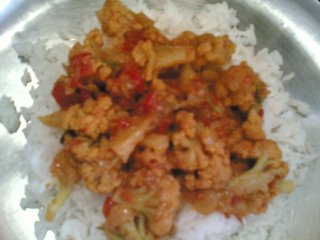 Ingredients:
Ingredients:
1 medium sized cauliflower (wash the florets and blanche in salted water)
8-10 garlic flakes
4 medium sized onions finely chopped
1/4 tsp turmeric pwd
1 tsp red chilli pwd
1/2 tsp coriander pwd
1/4 tsp cumin pwd
salt to taste
3 big tomatoes finely chopped
big pinch of garam masala pwd
oil
1/2 tsp jaggery(optional)
chopped fresh coriander leaves for garnish
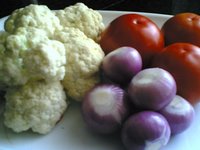
Heat 1 tsp butter or oil in a vessel and add the blanched florets and stir fry for 4-5 mts continuosly till you get a light golden color.Remove and keep aside.
In the same vessel add 1 tbsp oil and add garlic flakes and fry for 10-15 seconds.Now add the chopped onions and fry till transparent.
Add all the powders except garam masala and salt and mix well.
Add the tomaotes and cook till oil seperates.
Add the fried florets and cook covered on low heat for 3 mts.
Add 3/4 cup water,jaggery and garam masala and cook till you get the desired gravy consistency.
Garnish with chopped coriander leaves.
This low calorie and vegetarian recipe goes well with rice or rotis.
Food,Food Blogs,Vegetarian ,Indian Cooking,Antioxidants,Flickr
 Today the 29th of January is the start of the Chinese New year and the year of the Dog,the Fire Dog.Wish all those celebrating a happy,healthy and wealthy year of the dog that is full of joy,happiness, prosperity.
Today the 29th of January is the start of the Chinese New year and the year of the Dog,the Fire Dog.Wish all those celebrating a happy,healthy and wealthy year of the dog that is full of joy,happiness, prosperity.
Happy Chinese New Year!
 The Dog in Chinese Astrology represents loyalty,friendship, infinite courage,mighty fortitude and hidden strength.
The Dog in Chinese Astrology represents loyalty,friendship, infinite courage,mighty fortitude and hidden strength.
I went Indo-chinese with 'Chinese Sweet & Sour Chicken Legs' today,a starter dish which has a tangy,sweet and spicy flavor.I enjoy cooking Chinese inspired Indianised food and this dish doesnt require much effort and is a very simple recipe.You can play around with the spices and sauces.
Fish plays a large role in Chinese festive celebrations.On New Year's Eve it is customary to serve fish for dinner,symbolizing a wish for abundance in the coming year.I prepared an Indo-Chinese fish recipe,'Spiced Chinese Fish Fillet' which is not only easy to prepare but also tastes great.
Chinese Sweet and Sour Chicken Legs
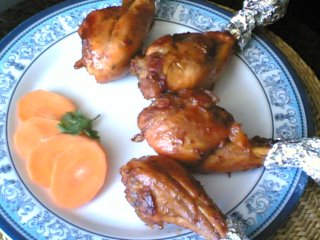
Ingredients:
6 chicken legs
4 tbsp tomato sauce
2 tbsp vinegar
1/2 tsp soya sauce
1/2 tsp red chilli pwd
1/4 tsp black pepper pwd
salt to taste
1 big onion finely chopped
2 dry red chilli deseed & tear into pieces(or chopped green chillis)
1 tsp grated ginger-garlic (optional)
1 tbsp oil
Wash chicken and drain water completely.Marinate the chicken with tomato sauce,vinegar,soya sauce,red chilli pwd and pepper pwd for half an hour.
Heat a vessel and add the marinated chicken and let the chicken cook in its own juices(dont add water.
Cover and cook till the chicken absorbs all the spices and sauces.Keep checking and stirring so that it doesnt burn.
Meanwhile heat oil in a pan.When hot add the onions,chillis and garlic-ginger and fry well on high heat stirring continuosly till well browned.Add the fried chicken legs and stir fry for 4-5 mts till well roasted and coated with the onions.Serve hot with salad.
Spiced Chinese Fish Fillet
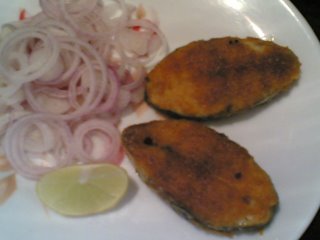
Ingredients:
fish fillets 6
1 tsp chinese 5 spices powder (equal parts of cinnamon,fennel,star anise,cloves and black pepper)
1 tsp soya sauce(optional)
1 tbsp vinegar
1 tbsp ginger garlic paste
salt
1/4 cup rice flour
oil for frying
Mix all the above ingredients except rice flour and salt and marinate the fish fillets with this mixture and keep aside for 1/2 hr.
Dust the marinated fish fillets with the rice flour and salt.
Heat 1-2 tbsp oil in a frying pan to medium-high and fry 2 fish fillets at a time for 2-4 minutes each side till golden brown.Pat dry with paper towel when done.Serve hot with salad.
Variation:Alternately,you can also dip the marinated fish fillets in all purpose flour,then dip in beaten eggs and then coat in bread crumbs before shallow frying.
Food,Food Blogs,Indo Chinese Recipes,Cuisine,Flickr
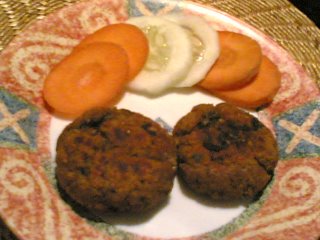
Hyderabad (capital of Andhra Pradesh) and Lucknow (capital of Uttar Pradesh) are the two cities in India where the "kebab" evolved. When and Who introduced the 'kebab' to India is another story which requires a separate post by itself..so let me reserve that for later.
Lucknow is famous for its kebabs and you will find the great great grandsons of bawarchis(Chefs) to the Nawabs(Kings) carry on the culinary tradition of their forefathers in their dhabas till today. Lucknow’s richly flavoured Avadh cuisine is specially known for the quality and quantity of spices used in cooking meat dishes.Murg tikka,fish tikka,paneer kebab,seekh kebab,kacche keeme ki kebab,kalmi kebab and tangiri kebab to name a few, are the famous Lucknowi mouthwatering array of specialities.
Hyderabad,our capital city,is the home of the Muslim Nawabs(rulers) and is famous for it’s Dum Biriyani,simply irresistable grilled kebabs, kurmas and the famous Shikampur Kebab (mutton mince cooked with cumin,cloves and cinnamon and bengal gram lentil and stuffed with cottage cheese,mint,onions and green chillies) and gently grilled on a griddle or tawa with pure ghee.Shikampur means ‘belly-full’ referring to the stuffing in the centre of the kebab.The famous Shammi Kebab of Lucknow is same as Shikampur Kebab without the stuffing.
Ingredients:
500 gms kheema (minced meat)
1/4 cup of Bengal gram lentil(soaked in water for 1/2 hr)
10 cloves garlic
1 tsp cumin seeds
5 pods green cardamom
2 sticks cinnamon
5 cloves
1/4 tsp turmeric pwd
1 tsp red chilli pwd
2 tbsp oil/ghee(clarified butter)
1 1/2 cup water
Mix all the above ingredients and bring to a boil and then bring to medium heat for 2 mts before reducing to low heat until all the water evaporates and the meat and dal is cooked.Stir occassionally to prevent burning.
Then add salt and blend in a mixie and knead it like a dough.Shape into round pattis.
For filling:
3 tbsp finely chopped onions
2 tbsp finely chopped fresh mint leaves
3 tbsp grated yogurt cheese
4 deseeded and chopped green chillis
salt
Mix all the ingredients for the filling.
Flatten the pattis and put a tbsp of the filling in the center and reshape into a patti.Refridgerate for 20-25 mts.

Pre-heat a griddle adding 2 tbsps of oil/ghee and shallow fry 3 kebabs at a time.Let them cook on low heat to medium heat.Flip over and brown both sides till golden brown.
Serve with salad,onion rings and lemon wedges.
Note:The authentic recipe calls for chunks of meat which is cooked in spices and pounded in a stone mortar.I have used minced meat out of sheer convenience..:)Food,Food Blogs,Indian Recipes,Indian Cooking, Flickr
Alysha of The Savory Notebook has started a new club called ‘Virtual Recipe Club’ where she has chosen to utilize this club to swap new recipes and share our favorites every month.This month’s (January) theme is – Whole Grain Breakfast Foods that contain whole grains like whole wheat flour,wheat bran,oat bran,wheat germ,millet,whole grain cornmeal,oats,buckwheat or barley.I have chosen to highlight the benefits of including Finger Millet or Ragi as a highly nutritious whole grain in our diets.
 The Latin name of Ragi is Elusine Indica which is a traditional crop of S.India and is also known as the poor man’s millet due to its long sustenance.The labouring farmers in our villages sustain on this whole grain which is more superior to rice or wheat in nutritional terms, being rich in proteins,providing highest levels of calcium,antioxidants properties, phytochemicals and high levels of dietary fibre which makes it easily and slowly digestable(hence helps control blood glucose levels in diabetics very effectively).The bulkiness of the fiber and the slower digestion rate makes us feel fuller on fewer calories, and therefore may help prevent us from eating excess calories.I have read this interesting article on fat loss with this wonder grain here ,where the author shows how we can manage to prevent obesity by incorporating ragi in our diet.
The Latin name of Ragi is Elusine Indica which is a traditional crop of S.India and is also known as the poor man’s millet due to its long sustenance.The labouring farmers in our villages sustain on this whole grain which is more superior to rice or wheat in nutritional terms, being rich in proteins,providing highest levels of calcium,antioxidants properties, phytochemicals and high levels of dietary fibre which makes it easily and slowly digestable(hence helps control blood glucose levels in diabetics very effectively).The bulkiness of the fiber and the slower digestion rate makes us feel fuller on fewer calories, and therefore may help prevent us from eating excess calories.I have read this interesting article on fat loss with this wonder grain here ,where the author shows how we can manage to prevent obesity by incorporating ragi in our diet.
I weaned my toddler to complementary foods to meet his nutritional requirements at 5+ months and one of the major health foods I gave him was ragi malt and research has proven that millet grains holds the key to a healthy, wholesome diet and has a better balance of vitamins and minerals than wheat, barley, oats, rice or rye.It has amazing amounts of iron, Vit B, complex protein, amino acids, phosphorus,magnesium and potassium and can be given to babies from age 5+ months as baby food like a porridge or combine it with milk/yogurt/veggies/fruits which is a complete nutritious baby meal.Ragi flour cooked with a little milk and sugar is a tasty and easily digestable breakfast cereal.
Our farmers and labourers,over the centuries have traditionally used ragi as an essential whole grain in their diet,especially in Karnataka and Andhra Pradesh states and most of their nutrition comes from the traditional Ragi Mudde (Kannada) or Ragi Sankati (Telugu) which is eaten in the morning with a chilli, onions, sambar (lentil based stew)or meat curry and helps them sustain throughout the whole day.
Similar to chapatis or parantas which are wheat flour based,we can prepare ragi rotis from ragi flour.Ragi roti is a traditional Karnataka breakfast dish prepared from ragi flour,fresh grated coconut,onions and green chillis.I usually prepare these ragi rotis with different vegetable stuffings using carrots,peas,cauliflower,drumstick leaves(mulaga akkulu)and methi leaves for added flavour and nutrition.
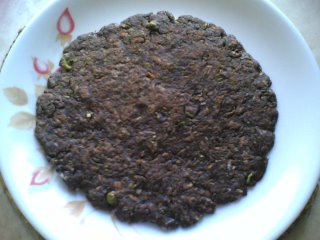
A highly nutritious and healthy food,Ragi Roti,making its entry for this month's Wholesome Grain Breakfast Food theme of Alysha's Virtual Recipe Club.
Ingredients:
1 cup ragi flour
2 finely chopped green chillies (you can use chilli pwd)
1/2 tsp cumin seeds
pinch of asafoetida or hing (optional)
1 tbsp chopped fresh coriander leaves
2 tbsp grated fresh coconut (optional)
1 onion finely chopped
½ cup cooked fresh vegetables (optional)..I have used grated carrots and boiled mashed green peas

oil for frying
a plastic foil for spreading the ragi dough into a circular shaped roti
Mix all the ingredients, except oil.
Add just enough water to make a firm dough.
Divide big lemon sized balls.Take a plantain leaf or butter paper or a plastic foil and place a ball on it and flatten with your fingers spreading it as thin as possible into a circular shape of approx 6" in diameter.
Pre-heat the griddle spreading a tsp of oil and carefully transfer the rolled out ragi roti onto the griddle.
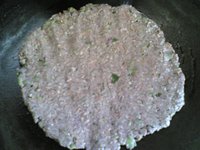
Cook for about a minute,flip and cook for another minute.Keep flipping till its well cooked on both sides.
Serve hot with chutney.I like to eat my ragi roti with curd and lime pickle.
The traditional Ragi Sankati of Rayalaseema fame has been blogged by Indira of Mahanandi in her blog and you can find an authentic recipe of famous traditional Kannada Raagi Mudde here.You can also check out Vkn's Ragi Dosa recipe at his Dhaba.I'd also like to share with you this article on the benefits and the importance of eating a healthy breakfast.
Food,Andhra Recipes,Millet,South Indian Cooking,Traditional Home Cooking
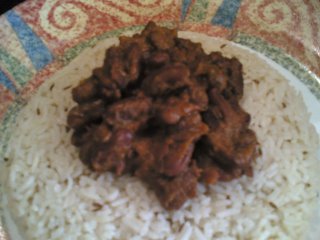 Sweetnicks is hosting ARF/5-A-Day cooking event where food bloggers can submit their ARF(Antioxidant Rich Foods) recipes every Tuesday where she does a round up of all the recipes submitted.It sure is a great theme to keep us healthy as we share some great antioxidant food recipes with one another.This is my entry for this week's ARF 5-Day Tuesday #4.
Sweetnicks is hosting ARF/5-A-Day cooking event where food bloggers can submit their ARF(Antioxidant Rich Foods) recipes every Tuesday where she does a round up of all the recipes submitted.It sure is a great theme to keep us healthy as we share some great antioxidant food recipes with one another.This is my entry for this week's ARF 5-Day Tuesday #4.
Why do we need to eat more anti-oxidant rich foods?What are anti-oxidants and why do we need them?Well,antioxidants help protect healthy cells from the damage caused by free radicals.What are free-radicals,you may ask? Free radicals are unstable, reactive molecules with a free electron that seek to latch onto whatever they can find and are generated by the metabolism of oxygen and other chemicals.Unsaturated fats, certain reactive chemicals, both inhaled and consumed in food or water, microbes,polluted environment and smoking cigarettes all generate free radicals. When these free radicals are not countered by antioxidant nutrients, they may attack healthy cells,cell membranes, fat molecules, or tissue linings in our body and weaken them and if left unchecked, they may contribute to heart damage, cancer, cataracts and other illnesses and may also weaken our immune system.So you want to fill your body with an abundance of antioxidants, while you do your best to avoid oxidant poisons.Antioxidants, also termed as "free-radical scavengers," protect us by binding the free radicals and when we get sufficient levels of these antioxidants, such as vitamin E and Vitamin C, selenium, and beta-carotene in our diet, we can neutralize the free radicals and prevent cellular and tissue damage. For an better overview and understanding of free radicals and antioxidants follow this link.
In her search for anti-oxidant food sources,Alanna of A Veggie Venture came up with a helpful list of antioxidant food sources and she goes on to define these food sources in a very interesting manner.. "The best list of antioxidant-rich vegetables is the list of vegetables you'll actually eat."I couldn’t agree more on that.
 Red Kidney Beans or Rajma (Hindi) are a rich source of anti-oxidants and contains cholesterol-lowering fiber which prevents blood sugar levels from rising too rapidly after a meal, making them a very good food source for diabetics.When red kidney beans are combined with whole grains such as rice, they provide an almost fat-free high quality protein. Rajma is quite a popular bean in North India and can be best associated with Rajma Chawal (red kidney beans with rice), the basic staple of N.India and an extremely popular dish which is a complete meal in itself.A signature Punjabi dish ,Rajma is curried beans simmered in spiced gravy of onions and tomatoes which reflects the taste of authentic North Indian cuisine with its rich flavor and appetizing aroma.I generally use kidney beans to prepare rajma curry to go with hot steamed rice,stuffed parathas or salad.I try to incorporate red beans in our diet as much as possible....and rajma curry (with jeera rice) is one of my favourite beans curry.
Red Kidney Beans or Rajma (Hindi) are a rich source of anti-oxidants and contains cholesterol-lowering fiber which prevents blood sugar levels from rising too rapidly after a meal, making them a very good food source for diabetics.When red kidney beans are combined with whole grains such as rice, they provide an almost fat-free high quality protein. Rajma is quite a popular bean in North India and can be best associated with Rajma Chawal (red kidney beans with rice), the basic staple of N.India and an extremely popular dish which is a complete meal in itself.A signature Punjabi dish ,Rajma is curried beans simmered in spiced gravy of onions and tomatoes which reflects the taste of authentic North Indian cuisine with its rich flavor and appetizing aroma.I generally use kidney beans to prepare rajma curry to go with hot steamed rice,stuffed parathas or salad.I try to incorporate red beans in our diet as much as possible....and rajma curry (with jeera rice) is one of my favourite beans curry.
Ingredients:
1 cup red kidney beans soaked overnight
3 cups water
1 big onion
1 bay leaf (optional)
1 tsp chopped ginger
1 tsp chopped garlic
pinch of asafoetida(optional)
pinch of turmeric powder
1 tsp cumin seeds
1 tsp red chilli powder
2 big tomatoes finely chopped
1/4 tsp of ground garam masala (2 cloves,1/2" cinnamon and 1 green cardamom)
1/2 tsp cumin pwd
1 tbsp coriander pwd
1 1/2 tbsps oil or ghee(clarified butter)
salt to taste
chopped fresh coriander leaves for garnish(optional)
Wash the kidney beans and soak in water overnight.Next morning, pressure cook until soft or cook in a large pot of water till soft.Remove half a cup of cooked beans, crush coarsely and keep aside.
Grind onion, ginger and garlic to a very fine paste.
Heat ghee/oil in a cooking vessel and add cumin seeds and let them brown.Add the asafoetida and stir fry for few seconds and then add the ground onion paste and saute until golden brown sprinkling water occasionally until the ghee starts separating from the paste.
Add red chilli pwd,turmeric pwd,coriander pwd,cumin pwd and salt.Mix well.
Add the tomatoes and cook till ghee seperates.
Add the cooked whole beans along with the residue water left while pressure cooking it.Cover and cook for 3 mts.
Add the crushed kidney beans and a cup of water.Mix well.Add garam masala and cook till required gravy consistency.
Garnish with chopped coriander leaves.
Serve hot with steamed rice,jeera rice,chappatis or phulkas.

Lulu of Lulu Loves London shares another tasty rajma recipe, Kashmiri Rajma.
Jeera Rice
Ingredients:
1 cup long grain rice or basmati rice
1 tbsp ghee
1 tbsp cumin seeds
1 bay leaf
1/4 tsp sugar
1/4 tsp clove-cinnamon powder
1 1/2 cups water
salt to taste
Wash rice well and soak in water for 20 minutes.
Heat ghee in a heavy vessel.Add the cumin seeds and let them turn brown.
Add the bay leaves and fry for few seconds.Add sugar and drained rice(keep aside the drained water)gently stiring for a mt.
Add spice powder and salt.Mix.Add water and bring to a boil.
Cover and cook on simmer till rice is cooked and water evaporates and see that each grain is separate.Serve hot with rajma or any curry of your choice.
Dawna of Always In The Kitchen shares an interesting recipe Jamaican style Beans and Rice.Food,Beans,North Indian Recipes,Antioxidant Foods, Flickr
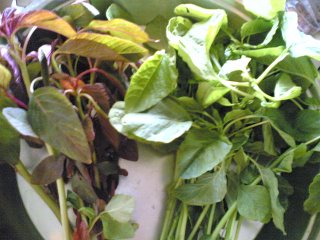 “Amaranth, though relatively unknown today, was cultivated as a food crop in Mexico as early as 7000 years ago. Amaranth grain constituted a principal source of protein for the pre-Hispanic populations of Mesoamerica. Along with beans and corn, amaranth was a fundamental part of the indigenous Mexican diet.”
“Amaranth, though relatively unknown today, was cultivated as a food crop in Mexico as early as 7000 years ago. Amaranth grain constituted a principal source of protein for the pre-Hispanic populations of Mesoamerica. Along with beans and corn, amaranth was a fundamental part of the indigenous Mexican diet.”
This was news to me.I thought Amaranth or Thota kura, as its called in our state of Andhra Pradesh, was native to Indian and China.I was wrong. (I must appreciate and thank Kalyn of Kalyns Kitchen for starting a wonderful theme.If not for her,I surely wouldnt know so many facts about different herbs and vegetables) Amaranth has been used for centuries because of its nutritional qualities and today its value has been re-discovered by the health-conscious who have developed a liking to it because of its ability to provide high nutrition both as a vegetable and as a grain.I found some interesting facts on the history of Amaranth here.
(I must appreciate and thank Kalyn of Kalyns Kitchen for starting a wonderful theme.If not for her,I surely wouldnt know so many facts about different herbs and vegetables) Amaranth has been used for centuries because of its nutritional qualities and today its value has been re-discovered by the health-conscious who have developed a liking to it because of its ability to provide high nutrition both as a vegetable and as a grain.I found some interesting facts on the history of Amaranth here.
Amaranth is herbaceous plant of the genus Amaranthus, is also known as Chinese spinach, choy, , tamri bhaji,chauli,thota kura, mullukkirai Jacob's coat, Joseph's coat. The edible tender leaves and stems, rich in vitamins A and C, protein,folic acid,calcium and iron, are considered as vegetable and are cooked like spinach. Iron levels in amaranth leaves are three times more than those of spinach and the leaves have a taste similar to spinach, but are much sweeter. These leaves are low in saturated fat, and very low in cholesterol and also a very good source of Riboflavin, Vitamin B6, Magnesium, Phosphorus, Potassium, Zinc, Copper and Manganese. Amaranth is generally available as a red variety (such as red saag,red spinach or red leaf amaranth) or as green amaranth (such as green pointed leaf,tender leaf or green round leaf).The picture above reflects both the red and green amaranth variety.For more information (with pictures) on different varieties of Amaranth leaves follow this link.
Amaranth is considered to be one of the most nutritious plant in the world.Popped amaranth seeds provide a good source of protein which can satisfy a large portion of the recommended protein requirements for children and can also provide approximately 70% of necessary calories. A combination or rice and amaranth, in a 1:1 ratio, has been designated as an excellent way to achieve the protein allowance recommended by the World Health Organization.
Amaranth is a multi-purpose plant in India. The tender leaves and shoots of the amaranth plant are relished as a green vegetable and are excellent for stir-fries and soups. In some regions of the country,the grains are popped and mixed with milk and sugar to prepare kheer(sweet drink) and without milk to prepare halwa(sweet pudding). The roasted and partially popped grains are milled into flour and used to make rotis(flat Indian bread)or, fried in oil to make puris(puffed Indian bread) or crisp pakoras(fritters).
To prepare any recipe using amaranth,wash the greens thoroughly and slice the older woodier stems and use only the tender stems and leaves,which have a mild spinach flavor,for salads.Stems and leaves that may be more mature can be used in stir-fry dishes, soups and steamed dishes with noodles.
In Andhra ,Thota Kura is used to prepare dal (lentil)dishes,stir-fries and soups.Today’s recipe is Thota Kura Peasarapappu which is a stir fry lentil dish cooked with amaranth leaves.Very nutritious, tasty and goes well with rice and rasam.This dish goes well with hot steamed rice and rasam.
Ingredients:
2 cups chopped thota kura
1 small cup pesara pappu(split yellow moong dal) washed and boiled in 1 cup of water till soft but not mushy.The dal must be intact.(When ever I boil the pesara pappu I use the left over water to prepare rasam)
1 big onion finely chopped
3 slit green chillis
1 tsp chopped ginger

½ tsp mustard seeds
½ tsp cumin seeds
4-5 garlic flakes crushed
10 curry leaves
2 dry de-seeded red chillis(tear them into 2-3 pieces)
Heat 1 tbsp oil in a vessel.Add the mustard seeds and let them splutter.Now add the cumin seeds,garlic flakes,red chillis,curry leaves and stir fry for 15-20 seconds.Dont burn it.
Add the chopped onions,green chillis and ginger and fry on medium heat till transparent.Now add the chopped amaranth leaves and mix well.
Add the cooked dal and mix well,cover and cook for 5 minutes on medium heat and its ready to be served with hot steamed rice and rasam.

For more recipes on Amaranth follow this link. Food,Vegetables,Cooking,Andhra Recipes,Weekend Herb Blogging, Flickr
 Fusion cooking is basically the art of blending compatible flavours of different foods and cooking methods of East and West to create dishes which are unique,exotic and offer the best of both worlds.With the growing number of food bloggers sharing their food traditions and exposure to multi-cuisines and cooking methods,the enthusiasm to attempt at fusion cooking and bring forth my creative culinary endeavours is growing with each passing day.Of course,I would like to tread cautiously initially ,attempting at safe and familiar ‘mix and match’ foods and spices before embarking on more adventurous creations…:) At the end of the day you want your food to taste good and provide good nutrition and if our experiment with fusion cooking provides just that..what more can you ask for..:)
Fusion cooking is basically the art of blending compatible flavours of different foods and cooking methods of East and West to create dishes which are unique,exotic and offer the best of both worlds.With the growing number of food bloggers sharing their food traditions and exposure to multi-cuisines and cooking methods,the enthusiasm to attempt at fusion cooking and bring forth my creative culinary endeavours is growing with each passing day.Of course,I would like to tread cautiously initially ,attempting at safe and familiar ‘mix and match’ foods and spices before embarking on more adventurous creations…:) At the end of the day you want your food to taste good and provide good nutrition and if our experiment with fusion cooking provides just that..what more can you ask for..:)
Chinese cuisine is a very popular cuisine in India and one can find innumerable food joints serving Indo-Chinese fusion cuisine. A number of Indian kitchens,five star hotels,restaurants and wayside dhabas cook and serve this fusion food which involves a different cooking style i.e cooking in a wok with Indian herbs and spices like green chillis,red chilies,coriander,black pepper,garam masala and using Chinese cooking methods and spices like soya sauce,vinegar,tomato sauce,chilli-garlic sauce. This fusion food is very tasty, flavorful and a refreshing change for the Indian palate. Chilli Paneer,Gobi Manchurian, Crispy Schezuan Prawns, American Chopsuey ,Chilli Chicken and Rice dishes like Chicken Fried Rice and Veg Fried Rice are some of the Indo-Cuisine specialities.
One of my favourite cuisines is Chinese and there is something about it,whether it’s the nutrition factor or the special ingredients used or the presentation or the sheer simplicity in cooking style involving less cooking time…which just amazes me. In our home, Chinese Fried Rice is relished by all and its a simple and easy recipe that can be made in a jiffy and can be served alone or as an accompaniment to a main dish.This dish is so versatile that you can use a variety of veggies,chicken,shrimps,eggs,sprouts,corn kernels (let your imagination run wild)..well, it has a bit of everything spices, chillies, meat and vegetables.All I can say it’s a palatable dish that one cant resist.
"Fried rice with Choice of Flavors.There are more ways to make fried rice than I would care to count. Which is more authentically Chinese?...Fried rice, Chinese style, can be varied infinately by following a basic recipe and just changing the main ingredients used in conjunction with the rice. Roast pork, ham, chicken, or any type of seafood or preserved meats may be used."
--Jim Lee's Chinese Cook Book,Jim Lee [Harper Row:New York]1968
Sprouts Fried Rice is a prepared using sprouts,basmati rice and red chilli paste.Each grain of the cooked rice should be seperate and rice should be cold.Chinese wok-cooking is all about the timing of the ingredients and the proper tossing and mixing and maintaining proper temperature(flame).Barbara of Tigers & Strawberries has written a very interesting and in-depth article on home-style Chinese cooking,"Stir Fry Technique: Ten Steps to Better Wok Cookery".A must-read for those who love to cook Chinese.Here’s how the recipe goes:
Ingredients:
2 cups of cooked basmati rice
1 cup sprouts
1 tsp red chilli paste (soak 2-3 dry red chillis in 1 tbsp of malt vinegar for half an hour and make a paste)

1 tbsp. groundnut oil
½ tsp. soya sauce
1 tsp tomato sauce(optional)
salt to taste
1 tsp finely chopped garlic
1 tsp finely chopped ginger
white pepper pwd (as per your choice-its optional)
2 tbsp bell pepper jullienes or spring onions
Heat oil in a wok or large non-stick skillet till it nearly smokes and add the chopped garlic and ginger and stir fry for a few seconds on high heat.Keep tossing around so that it doesnt burn.
Add the red chilli paste and stir fry for 10-15 seconds.Now add sprouts and cover and cook for 2-3 mts on medium heat.
Add the soya sauce,tomato sauce,salt and white pepper pwd and mix well.
Add the completely cooled rice to the wok and stir fry tossing well for about 2 mts.Its important to note here that after adding the rice, flip the whole thing over as quickly as possible in order to coat the rice grains with the rest of the ingredients.
Garnish with bell pepper juliennes or spring onions.Serve hot.
Food,Food Blogs,Indo-Chinese Recipes,Rice, Flickr
 Admist most of the curries I prepare,Kadai Paneer,is probably one of the most favourite North Indian recipes I have learnt.This is a recipe I learnt from amma who in turn learnt it from our Punjabi neighbours (who taught us many authentic Punjabi delicacies like Sarson ka saag,Makki ki roti,Baigan bhartha).Infact the Matar Paneer Parantha recipe I had posted earlier is courtesy our affectionate Punjabi friends.When hubby dear informed me that an old friend of his was visiting us tonight,the first thought that occurred to me was the fresh paneer I made this morning and was sitting in the refrigerator.Kadai Paneer with rotis..perfect!
Admist most of the curries I prepare,Kadai Paneer,is probably one of the most favourite North Indian recipes I have learnt.This is a recipe I learnt from amma who in turn learnt it from our Punjabi neighbours (who taught us many authentic Punjabi delicacies like Sarson ka saag,Makki ki roti,Baigan bhartha).Infact the Matar Paneer Parantha recipe I had posted earlier is courtesy our affectionate Punjabi friends.When hubby dear informed me that an old friend of his was visiting us tonight,the first thought that occurred to me was the fresh paneer I made this morning and was sitting in the refrigerator.Kadai Paneer with rotis..perfect!
Kadai Panner,a typical Punjabi fare is a creamy curry dish where paneer (cottage cheese)cubes are cooked in a kadai(wok) with onion and tomato pastes and simmered with capsicum(bell peppers) and tomatoes and served in a small kadai(that's the way its served in Indian restaurants).The use of the herb Kasturi Methi (dry fenugreek leaves) as one of the ingredients imparts a strong aroma and flavour to this truly special and flavorful vegetarian dish.
Ingredients:
200 gms paneer (cottage cheese) cubed and sauté in a tbsp of ghee till golden brown and remove into a dish and add a cup of hot water to the fried paneer cubes and let them sit in it for 5 mts.Drain the water and keep aside.

1 big tomato (deseeded and diced)
1 big capsicum (bell pepper) diced
In the same kadai in which the paneer cubes were sauted,add the diced tomatoes and capsicum and sauté for 2-3 mts and remove from heat.
1 1/2 tbsp oil or ghee
3 medium sized onions (make a paste)
1 tsp ginger garlic paste
¼ tsp turmeric pwd
1 tbsp coriander pwd
1 tsp cumin pwd
1 tsp chilli pwd
1 cup tomato puree or paste
¼ tsp kasturi methi (dry fenugreek leaves)
¼ tsp garam masala (make a pwd of 3 cloves,2 green cardamoms and 1” cinnamon)
1 tbsp fresh cream(optional) for garnish
salt to taste
Heat ghee or oil in a kadai or vessel and add the onion paste and fry it well till oil separates.It should be well fried till the raw smell of onions disappears.
Add ginger garlic paste and fry for 3 mts.Add turmeric pwd,coriander pwd,red chilli pwd,cumin pwd and salt and mix well.
Add the tomato puree and mix well and cook for 5 mts.Add kasturi methi and the fried paneer cubes and let it cook covered for 2-3 mts.
Now add a cup of water,garam masala pwd and sauted capsicum and tomatoes and mix well.Cook for 5 mts covered.
Garnish with fresh cream and serve hot with rotis(Indian flatbreads)/naan or paranthas.

Note:You can prepare this dish without kasturi methi also.If you dont have kasturi methi,garnish with chopped coriander leaves.It tastes equally good.
Food,Food Blogs,North Indian Recipes,Indian Cooking,Curry
At some point or the other we all succumb to the cold virus and are left sniffing and sneezing all day long with a heavy head.Whenever you have a stuffy nose, those irritating symptoms that you experience are part of a natural healing process showing evidence that your immune system is combating illness. And when you cough ,you are clearing your breathing passages of thick mucus that would otherwise be a carrier of germs to the lungs. So you don't really don’t want to stop the bodies own cleansing process but would want to assist it to help eliminate the build up of mucus etc.
Ilva of Lucullian delights has tagged me for a Commom Cold Remedies Meme where I am supposed to share my best remedies for common cold.So here I go...
Inspite of the fast changing trends and the growing influence of modern medicine,there are still some valuable traditional herbal remedies today which have remained unchanged over the years.There are innumerable natural,tried and tested methods to alleviate common ailments and which leave no toxic residues or side-effects.The most popular traditional medical system in India is Ayurveda.Ammamma’s(my grandmother) kitchen always had bottles filled with specially formulated herbal remedies(‘churnam’) using herbs and spices like cumin seeds,fennel seeds,dry ginger,amla,cinnamon,mint,clove,turmeric,seasame seeds,neem,garlic,coriander,fenugreek....and many more for common ailments like cold,cough,fever,constipation,diarrhea,loss of appetite,acidity,headaches etc.She was uncompromising in kitchen and health matters..:)
According to Ayurveda, common cold results from an imbalance of the Kapha-Vata dosha.When there is excess of Kapha (cool,moist charactieristics) and excess Vata (reduction of agni or gastric fire) your body develops a cold. Ginger can reduce excess Kapha and restore agni, making it the best medicine for colds and flus.Herbs that can restore balance to Kapha are especially ginger(allam,adrak) and holy basil (tulasi),cinnamon(dalchini),licorice(athimadhuramu,jethimadh), black pepper and cloves(lavanga).
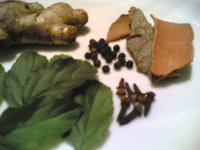
Drinking any of the above powdered herbs (1 tsp) mixed well in a cup of boiled water (let it sit for 10 mts)helps to alleviate cold.
Another excellent remedy is ginger tea.Add a small tsp each of ginger pwd, fennel seeds pwd,cinnamon pwd and a pinch of clove pwd to a cup of boiled water and let it sit covered for 10 mts.Strain and drink.You can have this tea a couple of times a day.
Another simple but very effective remedy is turmeric(pasupu,haldi).GM of The Spice Is Right has been able to overcome her cold woes with turmeric milk,an effective remedy for cold.Drinking this milk can help induce an early recovery.It helps keeping the lungs clear of phlegm and activates the liver.
Garlic is another extremely effective herb!Eating 5-6 raw garlic cloves a day and 1 to 2 raw garlic cloves for a couple of days after you have been relieved of your cold helps build your immune system.If you can't eat the whole clove,chop it and add it to salads..remember,it should be eaten raw and not cooked.
Hope these natural remedies for common cold help those of you with the cold woes.I am tagging the following food bloggers to learn some home remedies they use to overcome common cold.
Dawna of Always In The Kitchen
Gerald of Foodite
Kat of Cracker Jack'd
Tin of CJ's Food & Discovery
Zoubida of Kitchen Culture
Meme,Health,Home Remedies,Ayurveda,Ginger
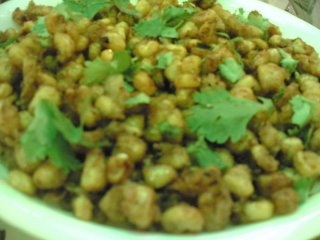
Maize,corn,mokkajonna,bhutta,....who doesnt love corn?I have such wonderful memories of amma roasting corn cobs and rubbing them with chilli pwd,salt and lemon juice especially during the monsoons.Eating piping hot corn on the cob is my kind of comfort food.Just love eating corn in all forms, be it corn bhel,corn chaat or flavoured ‘corn in a cup’ or just plain steamed corn kernels.I regularly prepare a healthy sprouts corn salad with fresh corn and sprouts which is healthy and a wholesome meal in itself.Corn is high-fibre food and is a good source of Vit B1, Vit B5,Vit C, Folate,phosphorous and manganese.
Crispy corn is a not-too-spicy snack that is prepared with corn kernels,egg,cornflour,ginger-garlic paste and pepper.This is something which can be made in a jiffy without much fuss and preparation..of course if the fresh corn kernels are cut off the cob already..:).That's the only part which is time-consuming..peeling off the husk layers and removing the corn from the cobs.If you have some frozen corn it sure makes life easy..:)
Ingredients:
1 ½ cups corn kernels
1 egg beaten slightly
enough cornflour to coat the corn kernels or seeds
1 tbsp maida(all-purpose flour)
1 tsp ginger-garlic paste
salt
oil for deep-frying
pinch of pepper pwd/chilli pwd (optional)
chopped coriander leaves for garnish
Mix together the corn kernels,egg,cornflour,garlic-ginger paste and salt such that the steamed corn is well coated with this mixture.
Heat oil in a vessel and deep fry the corn over high heat until golden brown.Drain on absorbent paper.
Sprinkle pepper pwd/chilli pwd and garnish with chopped coriander leaves.
Note:You can try this variation.Fry some chopped spring onions with a little tomato sauce in 1 tsp of oil and combine with deep fried corn and garnish with coriander leaves.Believe me,it's a great tasting snack.
Food,Food Blogs,Recipes,Indian Cooking,Corn
 Today is the third day of Sankranti festival and is called 'Kanuma' ..traditionally its the day devoted to giving thanks to cattle.Cows and bulls in the villages are adorned with bells on their neck and offered prasadam (food offering).Non-vegetarian delicacies are cooked and all the younger members of the family pay their respects to the elders and the elders gift them money and clothes.According to tradition followed since our forefathers,the new sons-in-law of the family are treated to lavish lunch spread with authentic Andhra non-vegetarian flavours like gongura mamasam(mutton cooked in red sorrel leaves),chepa pulusu(fish cooked in spicy tangy tamarind sauce),kodi kura (chicken curry),royallu vepudu(prawns/shrimp fry) and many more.. on ‘Kanuma’ day.
Today is the third day of Sankranti festival and is called 'Kanuma' ..traditionally its the day devoted to giving thanks to cattle.Cows and bulls in the villages are adorned with bells on their neck and offered prasadam (food offering).Non-vegetarian delicacies are cooked and all the younger members of the family pay their respects to the elders and the elders gift them money and clothes.According to tradition followed since our forefathers,the new sons-in-law of the family are treated to lavish lunch spread with authentic Andhra non-vegetarian flavours like gongura mamasam(mutton cooked in red sorrel leaves),chepa pulusu(fish cooked in spicy tangy tamarind sauce),kodi kura (chicken curry),royallu vepudu(prawns/shrimp fry) and many more.. on ‘Kanuma’ day.
We had a very sumptuous lunch spread this afternoon with non-vegetarian delicacies being the ‘theme’..During the festive season all the woman folk of the family lend a helping hand in the kitchen and since it’s a large family gathering everybody puts in their best effort to prepare the best tasting food possible that isn't too hot and has a nice balance of spices with aromatic flavours. They say "Too many cooks spoil the broth" ..well that quote sure doesnt apply here as many cooks add a lot of love,spice and flavour to the dishes being cooked this festive season..:).Its fun and that’s what celebrating festivals is all about.... a day of sharing,caring,laughter and relaxation.
Today I tried my hand at cooking a traditional Andhra fish gravy recipe,Chepa Pulusu,which is amma’s speciality dish.Chepa Pulusu is fresh fish cooked in a tangy tamarind sauce with freshly ground spices.This particular dish tastes best the next day (after the fish pieces are soaked in the tamarind and spice juices) served with hot steamed white rice and sliced onions.Must say that everyone enjoyed the dish though I felt it was no where compared to amma’s Chepa pulusu.I have come to realise that when I cook traditional recipes, they are so close to my heart as I have grown up eating amma's cooking and observing how she combines it all together to make the most tasteful dish one can ever eat.I guess it's the hand of amma’s love..:)
Ingredients:
7-8 fish fillets (mackarel or catfish or tilapia)
1 cup finely chopped onions
4 slit green chillis
1 1/2 tsp ginger garlic paste
1 tsp cumin pwd
1 tsp coriander pwd
1 1/2 tsp red chilli pwd
4 tbsp tamarind extract
1/4 tsp turmeric pwd
10-12 curry leaves
1 big lemon-sized tamarind pulp (soak tamarind in 2 cups of warm water and extract thick juice)
2 tbsp chopped fresh coriander leaves
salt to taste
1/2 cup oil
Tempering:
1/2 tsp mustard seeds
1/4 tsp methi seeds (fenugreek)
Heat oil in a wide vessel and add the mustard seeds and let them splutter.Add the methi seeds and let it brown.Add the curry leaves and stir for a few seconds.
Now add the chopped onions and fry on medium heat till the onions turn transparent. Add ginger-garlic paste and fry for 3 mts.Add the turmeric pwd,coriander pwd,cumin pwd,red chilli pwd and salt and fry for a minute.Now add the tamarind extract and bring it to boil.
Now carefully place the fish pieces in the vessel and cook covered for 3 mts.Add the green chillis. Turn the fish pieces over and cook.Cover and cook on low heat for 10 mts.Let the sauce thicken and till the oil seperates or leaves the sides of the vessel.Adjust salt and garnish with chopped coriander leaves.
Note:Do not stir too much lest the fish pieces break and be gentle while stirring the fish pieces.Serve it after a couple of hours of cooking so that the fish pieces absorb the tangy flavour of the tamarind sauce and spices.In Andhra, we generally prepare this pulusu with Koramenu,Vanjaram,Thella chepa or Bocha.Generally we dry roast the coriander seeds,cumin seeds and dry red chillis and make a powder for this dish.You can use the ready made powders also to save time.But if you have time to spare it would be best to dry roast the spices and make a powder.
Food,Andhra Recipes,Amma,South Indian Cooking,Indian Food Recipes,Authentic Andhra
Sankranti/Pongal, is the second day of the festival day when Surya, the Sun God is worshipped and on this day the newly harvested rice is cooked in new earthen pots until the cooked rice overflows from the pot.The overflowing symbolizes fertility and prosperity.A special sweet rice dish is prepared with dal, sugar or jaggery and rice called chakrapongali (rice pudding)…chakra meaning sweet and is cooked to honour and give thanks to God.I had posted this recipe earlier and you can find the recipe to Chakrapongali (also known as Sakkarai Pongal) here.
 On this day the newly married daughters and sons-in-law are focus of attention and are gifted new clothes and jewellry by the elders of the family and all the family members are treated to an elaborate Sankranthi Vindu Bhojanam (festive meal)spread out on plantain leaves where all the members of the home sit down on the ground and enjoy the festive lunch spread. This is my all time favorite meals.
On this day the newly married daughters and sons-in-law are focus of attention and are gifted new clothes and jewellry by the elders of the family and all the family members are treated to an elaborate Sankranthi Vindu Bhojanam (festive meal)spread out on plantain leaves where all the members of the home sit down on the ground and enjoy the festive lunch spread. This is my all time favorite meals.
Besides the preparation of Chakrapongali ,some of the mouth-watering authentic flavours of Andhra cuisine like Semai Payasam(sweet prepared with vermicilli and milk), Bobattu(stuffed Indian sweet bread), Masala Vada (deep fried doughnut shaped lentil dumplings), Pulagamu prepared with fresh rice from the harvest and pesara pappu (split yellow moong dal) ,Kalagalupu Kura (mixed vegetable curry) with chikkudu kaaya(lima beans), vankaaya (egg-plant or brinjal),mulaga kaadulu (drumsticks), kanda (yam),plaintain(raw banana),teepi dumpallu (sweet potatoes),mixed vegetable stew,kobari perugu pachadi (coconut-yogurt chutney) and daddojanam (curd rice) are prepared in almost every Telugu home.
One of my favourite sweets we prepared this Sankranti is Bobattu which is also known by the name of Puran Poli or Bhakshalu.Its basically a bread with sweet-lentil stuffing prepared with refined flour,sugar or jaggery and split bengal gram lentil.Amma makes excellent bobattulu and am posting amma's recipe on how to prepare them...(step by step process).In coastal Andhra its known by the name 'bobattu' and in the Telengana and Rayalseema region of Andhra its called as 'bhakshalu',though the basic recipe is the same..only the name differs.
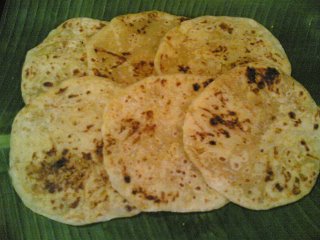
Ingredients:
1 cup chana dal(split bengal gram lentil) soaked in water for 2 hours and drained
1 cup jaggery or sugar(you can adjust the sugar or jaggery according to your choice)
1 1/4 cups maida (refined flour)
enough water to prepare dough
3-4 tbsps oil
1/2 tsp cardamom powder
1 tbsp clarified butter/ghee
pinch of salt
Cook channa dal in a cup of water in a pressure cooker till it becomes soft and mushy.Cool.Grind to a fine paste.
Heat a pan and add the dal paste and sugar or jaggery and cook further till they blend and form a lump such that you can prepare small balls for stuffing.Keep stirring on low fire so that it doesnt burn.
Add cardamom powder and pinch of salt and mix well.Turn off heat and cool.Prepare small lemon sized balls with this lentil mixture and keep aside.

Mix refined flour,pinch of salt,2 tbsps oil and enough water to make a very soft and sticky dough.Knead well.
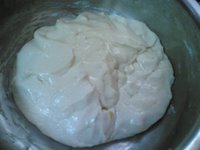
Grease your hands with oil to knead the dough and take a small portion of dough and flatten it into a disc of the size of your palm. Place a ball of "sweet lentil ball" in the centre and draw the edges of the dough from all sides to cover the 'sweet lentil ball' completely.
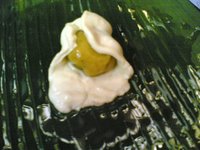
Take a sheet of transparent plastic wrap or a plaintain leaf and gently flatten each ball carefully with your fingers to form a 6" to 8" diamater flat circular bobattu/poli (grease your hands while flattening).
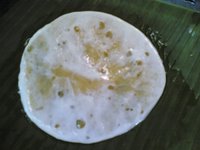
Fry it on low flame on a hot griddle or tawa.Roast both sides till brown spots appear.

Smear with ghee on both sides when done.Serve warm with clarified butter/ghee.
Note:You can store the 'bobattulu' for a few days in an air tight container or in the refrigerator.
Indian Food,South Indian Cooking,Andhra Recipes,Recipes,Authentic Andhra,Amma
 Annam Payasam or Paramannam (Food Of The Gods) is a sweet dish which is prepared as an offering to God in almost every home in Andhra on most special occasions and festivals.According to Hindu tradition & spiritual customs, by offering Naivedyam to God in the form of sweets like chakripongal, payasam,paramannam and fruits the devotees acknowledge the good things that come from God.After God partakes of the offering the naivedyam becomes prasadam. Prasadam is consumed after performing puja or worship and consuming the delicious prasadam symbolizes the bliss of self-realization.
Annam Payasam or Paramannam (Food Of The Gods) is a sweet dish which is prepared as an offering to God in almost every home in Andhra on most special occasions and festivals.According to Hindu tradition & spiritual customs, by offering Naivedyam to God in the form of sweets like chakripongal, payasam,paramannam and fruits the devotees acknowledge the good things that come from God.After God partakes of the offering the naivedyam becomes prasadam. Prasadam is consumed after performing puja or worship and consuming the delicious prasadam symbolizes the bliss of self-realization.
Paramannam can be served hot or cold as a dessert and is prepared with rice,milk and sugar or jaggery and garnished with raisins and cashewnuts.We prepared Paramannam as 'Prasadam'(offering to God) this morning on the occassion of Bhogi,the first day of Sankranti Festival and this is the recipe as prepared by Amma.
Ingredients:
1/2 cup raw rice washed and drained
1/2 cup sugar or grated jaggery
1 lt milk
pinch of salt
1/4 tsp ground green cardamom
fried cashewnuts and raisins for garnish
1 tbsp ghee(clarified butter)for frying cashewnuts and raisins
Wash and soak rice in water for about fifteen minutes.
Heat a pan and bring milk to a boil.Lower heat and add the rice to the milk.Cook until the rice is soft and the mixture looks thick.Remove from heat and cool.
Add the sugar and mix well and keep stirring till it mixes well.
Heat ghee in a skillet and add cashew nuts. Fry for 1-2 mts till the cashewnuts turn light brown. Add raisins and stir for a few seconds.Add this along with the remaining ghee to the cooked rice.Add cardamom powder and a pinch of salt and mix well.Turn off heat and keep covered for 5 minutes.Serve hot or cold.
Note:If you are using jaggery in place of sugar you must follow this method.Heat a small pan and boil 1/2 cup water and add grated jaggery.On slow fire let the jaggery cook till it melts and is sticky (if you touch a drop of the jaggery between the thumb and fore finger it should feel sticky).Dont let it heat too much,it should basically melt...approx 4-5 mts. Remove from heat and keep aside.Let it cool for 3-4 minutes and then add to the cooled cooked rice otherwise the milk might split.
Masala Vadas are popular South Indian deep fried crisp lentil dumplings prepared with channa dal(bengal gram lentil),onions and Indian spices.The outer crust is crisp,tastes great and is generally eaten as a snack.It can be eaten as it is or served with green chutney or coriander chutney.Paramannam,Masala Vada with masala chai ....our festive breakfast menu for Bhogi after offering prayers .
Masala Vada
Ingredients:
1 cup soaked and drained channa dal(split bengal gram)
1 tsp raw rice
1/2 tsp cumin seeds
4-5 flakes garlic
1" ginger chopped
5-6 curry leaves
4 green chillis
1 large chopped onion
1-2 tbsp chopped fresh coriander leaves
pinch of garam masala (optional)
1 tsp chopped mint leaves (optional)
salt
oil for frying
Soak channa dal and rice in water for 2 hours.Drain.Keep aside a fistful of drained channa dal and grind the rest of the channa dal and rice,green chillis,cumin seeds,ginger and garlic coarsely.To this coarse mixture, add chopped onions, curry leaves, coriander leaves,salt and garam masala and mix well.Add the remaining channa dal and mix well. Make small lemon-sized balls and pat it lightly on your palm or on butter paper and slide into hot oil and deep fry until golden brown.
Food,Desserts,Amma,South Indian Cooking,Andhra Recipes,Recipes
 "Sankranti Subbhakaankshalu!!Wishing you a memorable festive season which brings good luck & prosperity and hoping your days ahead are filled with happiness.Have a wonderful Bhogi & Pongal."
"Sankranti Subbhakaankshalu!!Wishing you a memorable festive season which brings good luck & prosperity and hoping your days ahead are filled with happiness.Have a wonderful Bhogi & Pongal."
“Unity in diversity”…this phrase is apt in identifying India in its diversity of religious beliefs and the cultural traditions of the different states.One festival which clearly reflects that is Sankranti ,one of the most colorful and popular festivals of Andhra celebrated with a lot of fervor and enthusiasm.Sankranti is a secular harvest festival celebrated in most parts of India under different names .. Sankranti(A.P,Karnataka),Pongal(Tamil Nadu),Makar Sankranti (Maharastra and Gujarat) and Lohri (Punja and Haryana). Sankranti which is the most important festival for us Telugus and is called 'Pedda Panduga' ( big festival) signifying that it is a time to discard the old and welcome the new and is the harbinger of more light and sunshine in life.Sankranti is celebrated over four days, the first day(13th Jan) is called 'Bhogi', the second day(14th) is 'Sankranti', the third day(15th) is, 'Kanuma' and the fourth day (16th), 'Mukkanuma'.
Inspite of the fast changing times with people migrating from villages to bigger cities in search of greener pastures and with cities expanding ,the spirit behind the way we celebrate our festivals has not quite changed.Bhogi,the first day is marked with gaiety and is celebrated on the eve of Sankranti or Pongal in all its entirety with traditional practices and customs which have been followed since our forefathers.
Early in the morning at 4 a.m ,a bonfire (Bhogimantalu) is lit on the occasion of Bhogi symbolizing ringing out the old to ring in the new.Old brooms, baskets,clothes,junk firewood,broken wooden furniture are all thrown into the fire signifying the cleansing of the house and a fresh start to the new year.Life is seen as a continuous renewal.This is the picture of our Bhogimantalu on Bhogi day at 5 a.m During this entire festive season women decorate their ‘vaakili’(the entrance to the house/front porch) with 'muggu/kolam/rangoli' of varied hues and sizes and place Gobbemmalu (small balls made from cow dung and decorated with marigold and pumpkin flowers)in the center.Muggulu are artistic intricate patterns drawn with hand on a washed surface using rice flour or chalk powder and decorated with colors and flowers and bring out the richness and uniqueness of Indian tradition and culture. Every muggu is reflective of the art and artistic capabilities that each woman possesses and is a celebration of life.Here's a picture of a simple 'Muggu' which my 3 year old help color this evening..:)
During this entire festive season women decorate their ‘vaakili’(the entrance to the house/front porch) with 'muggu/kolam/rangoli' of varied hues and sizes and place Gobbemmalu (small balls made from cow dung and decorated with marigold and pumpkin flowers)in the center.Muggulu are artistic intricate patterns drawn with hand on a washed surface using rice flour or chalk powder and decorated with colors and flowers and bring out the richness and uniqueness of Indian tradition and culture. Every muggu is reflective of the art and artistic capabilities that each woman possesses and is a celebration of life.Here's a picture of a simple 'Muggu' which my 3 year old help color this evening..:)
 In the evening many homes with children (below 4-5 years) arrange Bommala Kolluvu (arrangement of an array of toys and dolls) and Bhogipalla perentam (a gathering of women guests and relatives) where a mixture of regi pandlu(berries),senagalu (soaked and drained whole chick peas),flower petals,slices of sugar cane and small coins are showered over the heads of children dressed in new clothes to trickle down the blessings of elders,family and friends and remove 'dhristi '(protect from any evil eye). All the guests and relatives who are invited for the Perentamu are given a gift pack of assorted items (tambulam) which includes clothes, lentils, betel leaves, betel nuts, bananas, traditional sweets,flowers, turmeric and kumkuma.
In the evening many homes with children (below 4-5 years) arrange Bommala Kolluvu (arrangement of an array of toys and dolls) and Bhogipalla perentam (a gathering of women guests and relatives) where a mixture of regi pandlu(berries),senagalu (soaked and drained whole chick peas),flower petals,slices of sugar cane and small coins are showered over the heads of children dressed in new clothes to trickle down the blessings of elders,family and friends and remove 'dhristi '(protect from any evil eye). All the guests and relatives who are invited for the Perentamu are given a gift pack of assorted items (tambulam) which includes clothes, lentils, betel leaves, betel nuts, bananas, traditional sweets,flowers, turmeric and kumkuma.
Another great sight in every village during Sankranti is a decorated bull with multi-coloured attire moving from one house to another led by its master who plays the nadaswaram (flute) to the accompaniment of the dol (a drum). The 'gangireddi' is trained to perform a variety of feats like nodding in acceptance, kneeling and bowing down and even dancing!You will find the decorated bull going around each home here in the city too during the festival season.Old clothes, raw rice and money are given away to the gangireddula vadu (bull’s master) in charity on the occasion of Sankranti.Here's a picture of a fully adorned gangireddu with his gangireddi vaallu (masters) performing a feat in front of my ammamma's(grandmother)home.
 Bhogimantalu,traditional oil bath,muggullu decorated with gobbellu ,preparation of traditional sankranti sweets and savouries like ariselu and bobattulu(variety of sweet rice cakes),jantikulu(savoury made with chick pea flour),paalakaayulu(rice flour savoury),semai payasam(sweet vermicilli dessert),paramannam(sweet rice pudding),pulihora (tamarind rice ),masala vada (deep fried lentil dumplings)and many more...,new clothes & gifts given to house-hold helps and Bommala Kolluvu are the main features of Bhogi Panduga (festival).Picture of our Bhogi lunch spread(Vindu Bhojanam) on a plaintain leaf.
Bhogimantalu,traditional oil bath,muggullu decorated with gobbellu ,preparation of traditional sankranti sweets and savouries like ariselu and bobattulu(variety of sweet rice cakes),jantikulu(savoury made with chick pea flour),paalakaayulu(rice flour savoury),semai payasam(sweet vermicilli dessert),paramannam(sweet rice pudding),pulihora (tamarind rice ),masala vada (deep fried lentil dumplings)and many more...,new clothes & gifts given to house-hold helps and Bommala Kolluvu are the main features of Bhogi Panduga (festival).Picture of our Bhogi lunch spread(Vindu Bhojanam) on a plaintain leaf.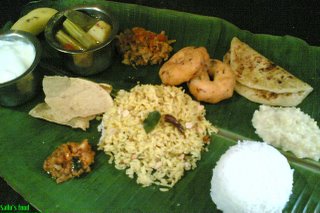
Pulihora or Tamarind Rice is a dish we prepare for most of our festivals in S.India.Its a tangy flavoured rice mixed in tamarind sauce and spices and garnished with roasted peanuts and tastes great with plain yogurt and appadam (papad).
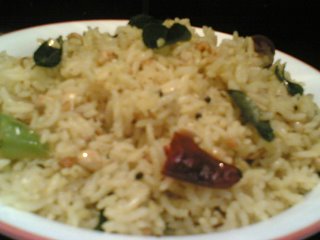 Ingredients:
Ingredients:
2 cups cooked rice (each grain should be separate)
1/4 tsp teaspoon turmeric (haldi,pasupu)
3-4 tbsp oil
salt to taste
20 fresh curry leaves
1/2 cup roasted peanuts
salt to taste
4 tbsps tamarind extract
1 tbsp channa dal (split bengal gram)
1 tbsp urad dal (split black gram)
1/2 teaspoon mustard seeds ( aavalu)
1 tsp cumin seeds (jeera)
5 medium dry red chili
4 green chilis slit length wise
1 tsp chopped ginger
1/4 tsp hing (asafoetida, inguva)
1 tbsp sesame seeds pwd(nuvvulu) (optional)
Mix the cooked rice with 2 tbsp oil,salt, turmeric pwd,roasted peanuts and 10 curry leaves. Keep aside.
Heat 2 tbsp oil in a vessel.Add the mustard seeds and let them splutter.Now add dry red chillis,cumin seeds,channa dal,urad dal and fry for 15-20 seconds till light brown.
Now add the slit green chillis,ginger,asafoetida and curry leaves and fry for 10 seconds.Now add the tamarind extract and cook till the raw smell disappears..approx 3-4 minutes.Add the seasame seeds powder and mix well.Remove from heat.
Add this to the rice and mix well.Adjust salt.
Serve with plain yoghurt.
Note:You can adjust the tamarind extract according to your taste.
Food,Food Blogs,Cooking,Indian Cooking,Andhra Recipes,Telugu
 New year brings promise and hope but not to this young child who is left at the mercy of nature.Can you imagine what it is to go hungry?Just imagine going without food for a day…..and there are millions who dont even get water to drink for days, leave alone eat a meal.This picture is so heart wrenching and is a harsh reminder of the grim reality that we are very fortunate while others suffer. UN Food and Agriculture Organization (FAQ) in the edition of their annual hunger report have stated that around six million children each year die of hunger and malnutrition.
New year brings promise and hope but not to this young child who is left at the mercy of nature.Can you imagine what it is to go hungry?Just imagine going without food for a day…..and there are millions who dont even get water to drink for days, leave alone eat a meal.This picture is so heart wrenching and is a harsh reminder of the grim reality that we are very fortunate while others suffer. UN Food and Agriculture Organization (FAQ) in the edition of their annual hunger report have stated that around six million children each year die of hunger and malnutrition.
Let us take this opportunity to change the life of a few needy people in this new year and help build a world without poverty. Are our thoughts trying to help sustain a soul in need? Or are they turning a blind eye to the one who cries for help? Are they reaching out to answer a call? Are we directing our thoughts to where they can do some good and really make a positive difference? God has equipped each of us with this great gift to convert our thoughts into powerful prayer-that is, praying for someone instead of just thinking about them. Thoughts turned into prayers will materialize into God's blessings,protection,power,strength and God's healing balm poured out on those we pray for.
This picture was e-mailed to me by a friend with her new year resolution not to waste food and requesting me to do the same.Our traditional upbringing has taught us to respect the food we eat as God (Para Brahma Swaroopam). Let us all resolve and pledge this new year – “not waste food”.
“I promise I will never waste my food no matter how bad it tastes and how full I may be. I pray that He will protect this little boy, guide and deliver him from his misery. I pray that we will be more sensitive towards the world around us and not be blinded by our own selfish nature and interests. “
This would be one of the best resolution’s we could ever strive for – “not waste food ever”. It is not a difficult promise to keep and serves as a constant reminder to us that we are all the same with each of us having equal right to survive. Should we allow this child’s call for help remain unanswered like screams of millions like him that exist and somehow don’t disappear when the camera shoots their plight? Those of us who follow the practice of not to waste food also have the responsibility to ensure that the people we know, our friends and loved ones also follow the same.Let us all endeavour in our efforts to spread the word among friends,loved ones and community to inculcate this healthy practice to “not waste food” and also to get our children into this habit so that they can promote it further.I hope this picture will always serve as a reminder to us of how fortunate we are and that we must never ever take things for granted.
I have made my promise.Will you all make yours too...never to waste food?!Its the least we can do for a hungry child.
"Those who tell you it can't be done have always been around, but throughout history progress has always come from those who said it could be done."
Food,Hungry,Poverty,Malnutrition,Blogs
 We were fortunate to have good Punjabi neighbours (in our growing years) who made some of the best paranthas and who taught us the art of preparing authentic Punjabi parathas.I grew up eating different varieties of stuffed parathas prepared with almost all vegetables and greens I can ever think of ..carrots,radish,potatoes,cauliflower, spinach,methi leaves,coriander,mint, onions, paneer, sprouts..and more.In fact, I relished eating parathas stuffed with left over dal,rice and veggies for breakfast, brunch or dinner.
We were fortunate to have good Punjabi neighbours (in our growing years) who made some of the best paranthas and who taught us the art of preparing authentic Punjabi parathas.I grew up eating different varieties of stuffed parathas prepared with almost all vegetables and greens I can ever think of ..carrots,radish,potatoes,cauliflower, spinach,methi leaves,coriander,mint, onions, paneer, sprouts..and more.In fact, I relished eating parathas stuffed with left over dal,rice and veggies for breakfast, brunch or dinner.
Paratha which is basically a N.Indian fare are unleavened flat breads similar to tortillas .The art of cooking up a paratha is something that is mastered over time..practice,practice and more practice.I must appreciate Paz of " The Cooking Adventures of Chef Paz" in her maiden attempt at preparing parathas.She sure did a great job...keeping in mind Indian Cuisine is absolutely new to her.I am yet to master the art making a perfect parantha like amma.
Parathas serve as a healthy wholesome food for growing children and for kids who dont eat their veggies,giving them stuffed parathas is a smart way to get them to eat their veggies.I get my child to eat his vegetables with stuffed paranthas and make it for breakfast and also pack it as a tiffin for him to eat at play school.Speaking of breakfast,Meena of Hooked on Heat is hosting yet another very interesting theme ..."breakfast". "Matar Paneer Paranthas" is the entry "From My Rasoi" for this month's breakfast theme.
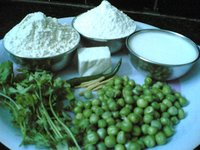
For the dough:
3/4 cup maida (all purpose flour)
1 cup atta (whole meal flour)
1 tbsp ghee (clarified butter)
salt to taste
3/4 cup buttermilk (whisk 2 tbsp yogurt with enough water to make 1 cup of buttermilk)
For the stuffing:
1 small cup boiled peas lighly mashed
1 small cup grated panner (cottage cheese)
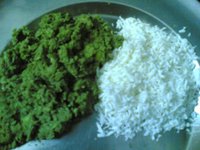
1" ginger
2-3 minched green chillis(you can reduce if you want less spice)
2 tbsp of chopped coriander leaves
1 tsp garam masala pwd
salt to taste
Mix the two flours,salt and ghee.Add enough buttermilk to the flours and knead a soft dough.Set aside covered with a thin wet cloth (so that the dough doesnt dry) and let it sit for an hour.
Mix together minced ginger and chopped coriander leaves and make paste.Mix the mashed green peas and this paste and stir fry for 2 mts in a little ghee.Add garam masala and a pinch of salt and mix.Finally add the grated cottage cheese and mix well and make small balls and keep aside.
Divide the dough into small portions(shape into lemon sized balls) and flatten each ball (approx 3"-4" in diameter) and put a small ball of the stuffing in the center.Cover the mixture by drawing the edges towards the center and mould into a ball again. 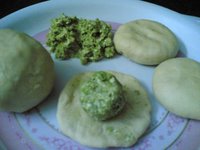
Take each of these stuffed balls and by pressing on a floured board ,roll into a round (pancake shape) (approx 6"-7" diameter) paratha with a rolling pin. Pre-heat a griddle or tawa and place a rolled out parantha and cook till small bubbles appear on top and then flip the paratha and cook it again for a few seconds or so by pressing with a spatula or kitchen towel.Brush little ghee/oil on both the sides along the edges and fry on both sides until brown patches appear.Keep flipping over both the sides and make sure that both the sides of the parantha are cooked well till golden brown.While preparing the paranthas ,keep the fried paranthas warm by placing them in a towel-lined basket or bowl and fold over the sides of the towel.
Note:Any left over dough can be refrigerated upto 3-4 days.The parathas taste just as good if not better and since the dough has been rested the paranthas can be rolled out easier.Serve hot with yogurt,green chutney or any curry of your choice.So here I am indulging myself to a hot parantha with mango pickle(aam ka achaar)and my favorite beverage,masala chai, to bring down the chill of a winter morning!
Food,Cooking,Recipes,Indian Cooking,North Indian Recipes

For this Weekend Herb Blogging hosted by Kalyn's Kitchen, I am blogging about a very interesting sour leaf called Red Sorrel.Hibiscus cannabinus aka red sorrel leaves,roselle,gongura (telugu)pulicha keerai (Tamil),Ambad bhaji,ambada,ambadi(Hindi) are popular sour greens here in the Southern State of Andhra Pradesh.Red Sorrel comes in two varieties, one is green leaf and the other being red variety which is more sour than the green/white stem variety.The leaves are bitter and mildly astringent and have a predominantly acidic taste.The Caribbeans prepare an exotic deep red sorrel punch, a sweet fruit drink with a wild tanginess from the flowers of the red sorrel plant ("sorrel" to Jamaicans) that form its base. These leaves and flowers have a cooling effect and act as an appetizer.
Red Sorrel has some health benefits too and is useful in relieving symptoms of fever. The leaves of this herb are useful in the prevention and treatment of scurvy which is a deficiency caused by lack of vitamin C. Fresh leaves of the plant are useful in stimulating the stomach and aiding its action. These leaves are beneficial in the treatment of jaundice and a tablespoon of fresh red sorrel juice mixed with butter-milk (made from cow's milk) is recommended once daily in the treatment of jaundice.

Gongura is available in abundance here and Gongura pachadi/pickle is a very popular authentic Andhra pickle variety on the lines of aavakai (raw mango pickle).These greens are used to prepare curries, stews, dals, and spicy pickles.In Andhra ,Gongura is used to prepare dishes such as Gongura Pappu (lentil),Gongura Vepudu(stir fry),Gongura royallu(prawns),gongura mamsam(mutton)and gongura pachadi,the recipe of which I am posting today.The recipe source is amma (my mother)who prepares excellent authentic andhra pickles.
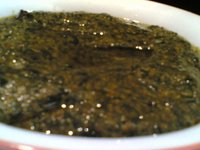
Ingredients:
4 big bunches fresh gongura leaves (red sorrel)
7-8 whole dry red chillis(de-seeded)
1 tsp methi seeds (fenugreek)
7-8 green chillis(less spice ones)
1 tbsp minapppapu (black gram dal)
1 tbsp senaga pappu (bengal gram dal)
1 tbsp coriander seeds
12-15 cloves garlic (peeled and lightly crushed)
4 tbsps oil
salt to taste
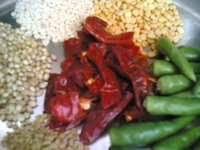
Tempering:
3 tbsp oil (yes,its 3 tbsps as its a pickle)
1 tsp mustard seeds
2 whole dry red chillis
10 curry leaves
Seperate the gongura leaves from the stalks and leave them in an open cool and dry place for 2 days so that the leaves wither.After 2 days wash the leaves.Spread over kitchen towel.
Heat 2-3 tbsp oil in a thick bottomed vessel.Add the leaves and fry them till rawness disappears and it becomes soft.Remove and cool.The fried leaves should look like shown in the picture.
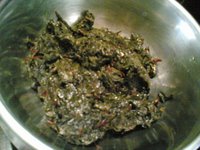
In the same vessel add 1 tbsp oil and add methi seeds and fry till light brown and then add coriander seeds,urad dal(black gram),channa dal (bengal gram lentil) and dry red chillis and fry stirring constantly till light brown.Add the slit green chillis and fry for 2 minutes.Remove from fire and cool.
Grind these above ingredients with salt.Now add crushed garlic and the fried gongura leaves and grind very coarsely.It should not be soft.
Now heat 3 tbsps of oil in a pan and add the mustard seeds and let them splutter.Now add the whole dry chillis and curry leaves and fry for 20 seconds.Remove from fire and add to the ground gongura pachadi along with the oil.This pachadi does require a wee bit more oil like most pickles.
This particular pickle can be stored in the refrigerator upto 3-4 weeks and goes well with hot steamed rice and a liberal dose of ghee and sliced raw onions.
Note:I have used the red stemmed variety of leaves which is more sour than the white stemmed.If you are using the leaves of the white stemmed variety,you can add approx 1-2 tbsp tamarind extract while grinding the ingredients.
Food,Cuisine,Cooking,Andhra Recipes,Weekend Herb Blogging
 Ingredients:
Ingredients:
















































